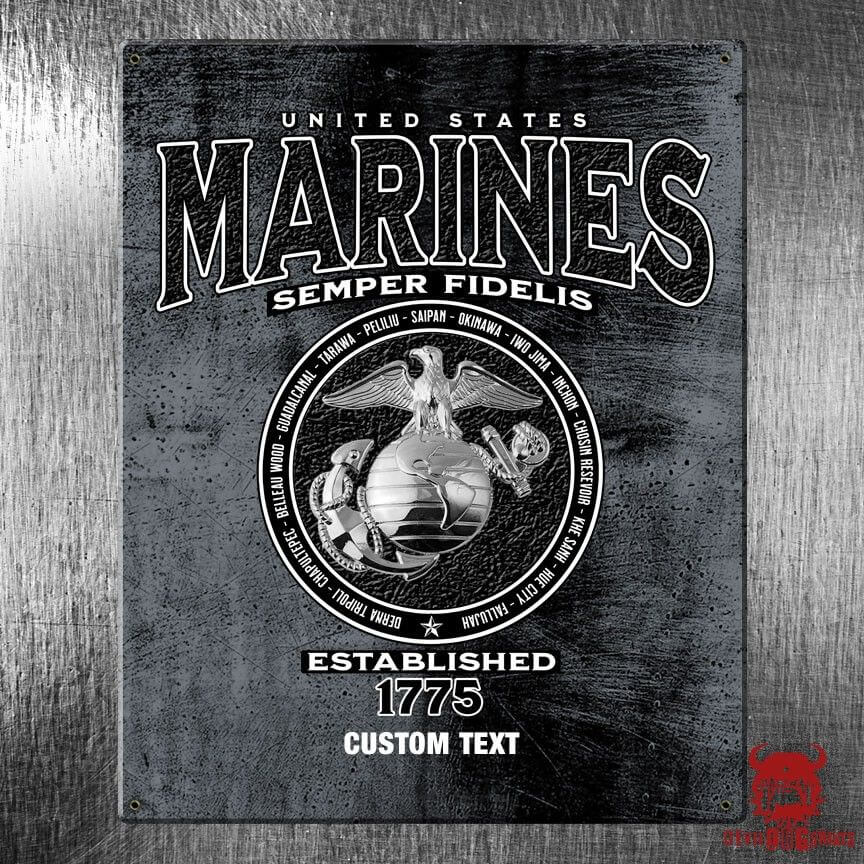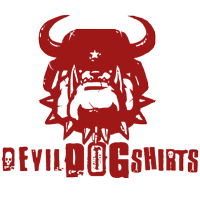Marine Corps Motto & Slogans
The United States Marine Corps has a long and illustrious history dating back to its founding at Tun Tavern on November 10, 1775. Over the years from the battles they have fought and the wars they have won that US Marines have picked up time honored nicknames like “Devil Dog” and “Leatherneck” and have fully adopted phrases “Semper Fidelis,” “the Few, the Proud,” and “Esprit de Corps.” From the Marines resounding ‘ Hymn to their famous Eagle, Globe, and Anchor (EGA) emblem, there is much to learn about the terminology of the Corps. Of all the military branches the USMC has one of the most proud and longest standing traditions in the names and nicknames they covet.

Semper Fi
The Marine Corps adopted the Latin motto “Semper Fidelis” back in 1883. Earlier than that date three other mottos, all more traditional rather than official USMC doctrine, were used. The first of these, antedating the War of 1812, was “Fortitudine.” These Latin words meaning “with courage,” was fashioned on the brass shako plates worn by US Marines during the Federal period. The second loosely adopted motto was “By Sea and by Land,” having been used by the British Royal Marines “Per Mare, Per Terram.” Up to and including the year 1848, the third motto was “To the shores of Tripoli.” Inscribed on the USMC colors, which commemorated Presley O’Bannon’s capture of the city of Derne in 1805. In 1848, this was revised to “From the halls of Montezuma to the shores of Tripoli.”
“Semper Fidelis” signifies the dedication that individual Marines have to “Corps and country,” and to their fellow Marines. It is a way of life. Said one former US Marine, “It is not negotiable. It is not relative, but absolute…Marines pride themselves on their mission and steadfast dedication to accomplish it.” Another reason the words “Semper Fidelis” meaning Always Faithful were whole heartedly taken in by every US Marine and their commands is that no US Marine or command has every mutinied. This faithful dedication and commitment to the both the United States and the United States Marine Corps lies central to this message and Latin term they have adopted.
(The source of the above text is The National Museum of the Marine Corps and Heritage Center. To visit their web site, Click here….
The Blood Stripe
Marine Corps tradition maintains that the red stripe worn on the trousers of officers and noncommissioned officers, commonly known as the “blood stripe,” commemorates those Marines killed storming the castle of Chapultepec in 1847. Although this belief is firmly embedded in the traditions of the Corps, it has no basis in fact. The use of stripes clearly predates the Mexican War.
In 1834, uniform regulations were changed to comply with President Andrew Jackson’s wishes that Marine uniforms return to the green and white worn during the Revolutionary War. The wearing of stripes on the trousers began in 1837, following the Army practice of wearing stripes the same color as uniform jacket facings. Colonel Commandant Archibald Henderson ordered those stripes to be buff white. Two years later, when President Jackson left office, Colonel Henderson returned the uniform to dark blue coats faced red. In keeping with earlier regulations, stripes became dark blue edged in red. In 1849, the stripes were changed to a solid red. Ten years later uniform regulations prescribed a scarlet cord inserted into the outer seams for noncommissioned officers and musicians and a scarlet welt for officers. Finally, in 1904, the simple scarlet stripe seen today was adopted.
(The source of the above text is The National Museum of the Marine Corps and Heritage Center. To visit their web site, Click here…)
The Few. The Proud.
“The Few. The Proud. The Marines.” has been used by the Marine Corps since 1977. It won a place on Madison Avenue’s Advertising Walk of Fame during Advertising Week 2007. “This slogan reflects the unique character of the Marine Corps and underscores the high caliber of those who join and serve their country as Marines,” said Maj. Gen. Richard T. Tryon, commanding general, Marine Corps Recruiting Command.
Ooh Rah
An expression of enthusiasm used by Marines in various situations. Specifics regarding the origin of the spirit cry are sketchy and we’re still searching for accurate and reliable information.
First to Fight
Marines have been in the forefront of every American war since the founding of the Corps. They have carried out over 300 landings on foreign shores. They have served everywhere, from the poles to the tropics. Their record of readiness reflects pride, responsibility and challenge.
Leathernecks
In 1776, the Naval Committee of the Second Continental Congress prescribed new uniform regulations. Marine uniforms were to consist of green coats with buff white facings, buff breeches and black gaiters. Also mandated was a leather stock to be worn by officers and enlisted men alike. This leather collar served to protect the neck against cutlass slashes and to hold the head erect in proper military bearing. Sailors serving aboard ship with Marines came to call them “leathernecks.”
Use of the leather stock was retained until after the Civil War when it was replaced by a strip of black glazed leather attached to the inside front of the dress uniform collar. The last vestiges of the leather stock can be seen in today’s modern dress uniform, which features a stiff cloth tab behind the front of the collar.
The term “leatherneck” transcended the actual use of the leather stock and became a common nickname for United States Marines.
(The source of the above text is The National Museum of the Marine Corps and Heritage Center. To visit their web site, Click here…)
Devil Dogs
In the Belleau Wood fighting in 1918, the Germans received a thorough indoctrination in the fighting ability of the Marines. Fighting through supposedly impenetrable woods and capturing supposedly untakeable terrain, the persistent attacks, delivered with unbelievable courage soon had the Germans calling Marines “Teufelhunde,” referring to the fierce fighting dogs of legendary origin. Ooohhh Raaah!
Esprit de Corps
The “spirit” of a unit. This spirit is commonly reflected by all members. It implies devotion and loyalty to the Marine Corps, with deep regard for history, traditions and honor.
Uncommon Valor
Refers to the victories in World War II, especially at Iwo Jima, the largest all-Marine battle in history. Admiral Nimitz’s ringing epitome of Marines fighting on Iwo Jima was applied to the entire Marine Corps in World War II: “Uncommon valor was a common virtue.”
Gyrenes
The term “gyrene” is a jocular reference to Marines which was first used in England as early as 1894. It was used in the United States around the time of World War I. Its exact origin is unknown, but it did appear to have a derogatory meaning in its early usage. It has been suggested that the term may embody a reference to pollywog, a naval slang term for a person who has not yet “crossed” (the equator), hence, a landlubber.
Jarhead
A slang term used by sailors as early as World War II to refer to members of the Marine Corps, drawing the term from the resemblance of the Marine dress blues uniform, with its high collar, to a Mason jar.
For more information regarding Marine Corps Motto & Slogans please contact us at hq@devildogshirts.com.

